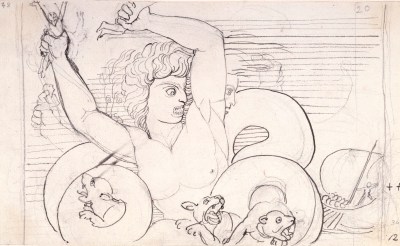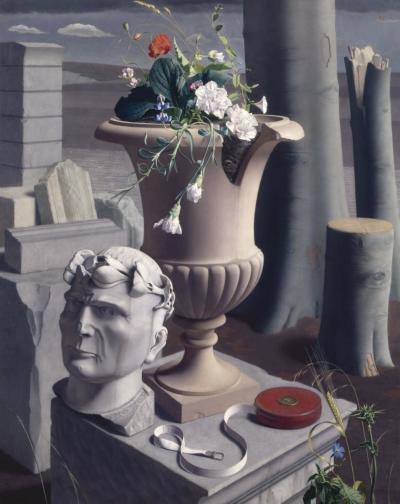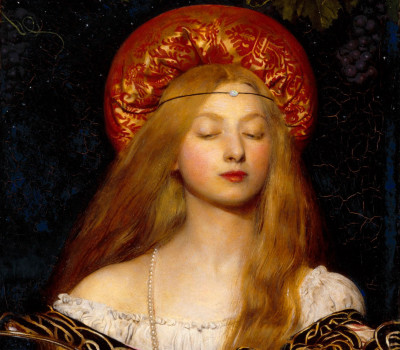How to read it: our copy of Leonardo’s Last Supper
How to read it: our copy of Leonardo’s Last Supper
By the RA Collections team
Published 22 March 2019
Within the RA’s Collection Gallery is a full-size copy of Leonardo da Vinci’s ‘Last Supper’, painted by one or more of his pupils. What can it tell us about the original masterpiece?
-
The painting depicts Jesus’s declaration that he would be betrayed
The last supper was the last time that Christ sat down and ate with his apostles before he was crucified. St. Matthew’s Gospel (chapter 26, verse 21) in the Bible explains that during the last supper, Christ says “one of you shall betray me” and the apostles “were exceeding sorrowful” and began to say “Lord, is it I?” Leonardo believed that the poses, gestures and facial expressions should reflect the “notions of the mind” or what people were thinking. Judas, the apostle who betrays Christ, is the only one whose face is in shadow and is shown in the RA copy without a halo.At the last supper, Christ asks his apostles to eat and drink in remembrance of him once he had gone. This ceremony became known as the Christian sacrament of the Eucharist in which bread and wine are consecrated and consumed. The apostles on the right hand side may refer to this as many of their hands are facing upwards as if they are receiving the sacrament. The wall on the left between the tapestries is black in response to the betrayal of Christ whereas the wall to the right is white reflecting the hopeful message of the resurrection.
In the original, Christ’s feet have gone walkabout
Leonardo da Vinci painted the Last Supper over 500 years ago between 1492 and 1497-48 in Santa Maria delle Grazie in Milan. The mural was painted in an experimental technique of tempera and oil on plaster, a kind of dry fresco, and its condition started deteriorating very soon after it was painted.In 1652, a door was inserted in the lower centre of the fresco so Christ’s feet are no longer visible. The Last Supper has been restored 19 times before the most recent conservation work which took 20 years to complete.
-

Giampietrino and Giovanni Antonio Boltraffio , Copy of Leonardo's The Last Supper , c.1515-20 .
Part of the RA CollectionOil on canvas. 3020 mm x 7850 mm. © Photo: Royal Academy of Arts, London. Photographer: Prudence Cuming Associates Limited.
-
Leonardo’s composition is clearer in the RA copy
The RA copy is believed to be the most accurate record of the original, even though it is missing the top part of the painting. It was painted c.1515-20, before the most serious deterioration of the original had happened. In fact, the RA copy was lent to Milan to help with the conservation of the original.The genius of Leonardo’s composition is much clearer in the RA copy. The apostles are arranged into four groups of three and there are many subtle interactions between the figures. Leonardo believed that gestures were very important in telling the story. He explained that the power of his compositions were such that “your tongue will be paralysed with thirst and your body with sleep and hunger before you depict with words what the painter shows in a moment”.
There are many elements in the copy which are more distinct that the original, such as the figure of Judas clutching his money bag and knocking over the salt. The landscape beyond the windows with its valleys, lakes and paths is well preserved in the copy, but has almost disappeared in the original. Leonardo’s use of colour was was greatly admired, but in the original the colours are very faded – Saint Simon on the extreme right clearly wears a pink cloak, but this is not visible in the original.
-
Your tongue will be paralysed with thirst and your body with sleep and hunger before you depict with words what the painter shows in a moment.
Leonardo da Vinci
-
It is not known for sure who painted this version…
…But it is strongly believed to be by one or more of Leonardo’s pupils, who would have worked alongside him in his workshop. The artist Giampietrino (active 1500-1550) is considered a likely candidate. He was probably a live-in apprentice of Leonardo during his Milanese period, joining the workshop in the mid-1490s. If this is accurate, Giampietrino would have been present when Leonardo was painting his Last Supper and possibly even assisted his master.A name that was often mentioned in the early literature about the Last Supper copy was Marco D’Oggiono (c.1467-c.1524), who was one of Leonardo’s best known followers. However, other copies of the work attributed to him (including one in the collection of the French National Museum of the Renaissance) appear stylistically different to the RA’s, with sharper contours and stronger tones.
The last name associated with the RA copy is Giovanni Antonio Boltraffio (c.1467-1516). He was recorded in 1491 as being in Leonardo’s studio and is known to be one of the principal pupils in his Milan workshop.
It has also been suggested that more than one hand could be responsible for this large copy. Perhaps Boltraffio worked on the left hand side, and then after his death in 1516 maybe Giampietrino completed the work.
We shelled out 600 guineas for it
It’s thought the copy had been privately owned until it was sold to a Carthusian monastery in Pavia, Italy in 1591. It remained in the monastery until about 1793 when, following the Austrian suppression of the Carthusian monasteries, it was sold. It was then displayed in the Brera Academy in Milan for many years, before being sent to England in 1817 to be sold again.Many Royal Academicians went to see the copy and were unanimous in their admiration, but it took several years before the RA actually bought the painting. According to Henry Fuseli RA, it was “rescued from a random pilgrimage by the courage and vigilance of our President who was by then Sir Thomas Lawrence.”
The RA paid 600 guineas for the copy, the equivalent of more than £36,000 today, which was the most they had ever paid for anything for the Collection. It required all Royal Academicians to attend a General Assembly meeting to agree the purchase.
-
-

Our ‘Last Supper’ was used to teach art students
The painting was bought for students of the RA Schools to study and copy. Joshua Reynolds, the first President of the RA, encouraged students to contemplate the work of the Renaissance masters such as Leonardo. This copy would have allowed students to understand the scale and colouring of this great masterpiece.Professors of the RA also gave lectures in front of the work, as can be seen in this print of the sculptor Sir Richard Westmacott RA lecturing in the Great Room at Somerset House in 1830, to an audience of RA Schools students, Academicians and guests. Henry Fuseli RA, Professor of Painting, gave his 11th lecture in front of “this magnificent record of the original glory of Leonardo’s now-faded masterpiece.”
-
-
Mary vs John?
Sitting to the left of Jesus is a figure with long hair and no beard who looks quite feminine. Authors such Dan Brown in The Da Vinci Code speculated that this was Mary Magdalene. This figure is in fact Saint John the Evangelist, who is often depicted as a beardless youth with long hair. There is no evidence to suggest Mary Magdalene sat down with the apostles at the last supper.
-
-
Visit the Collection Gallery
The Making of an Artist: The Great Tradition
Does great art begin with studying nature, or studying the great art of the past? Decide for yourself in this gallery, which brings together highlights from the RA Collection, among them our copy of Leonardo’s Last Supper. Entry is free.

-






